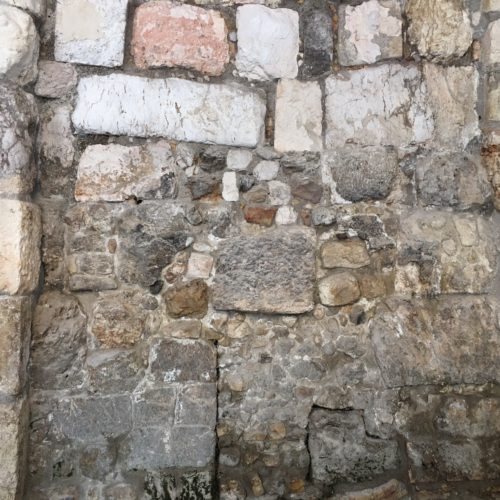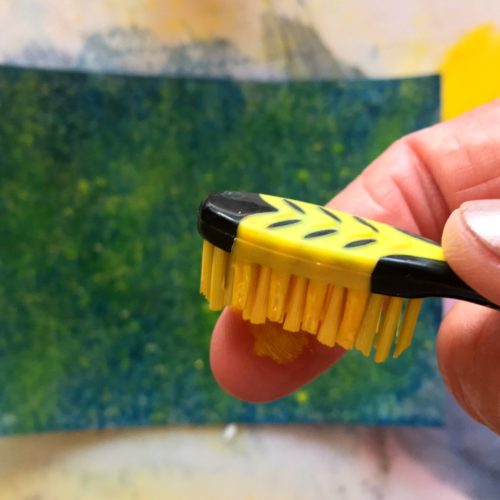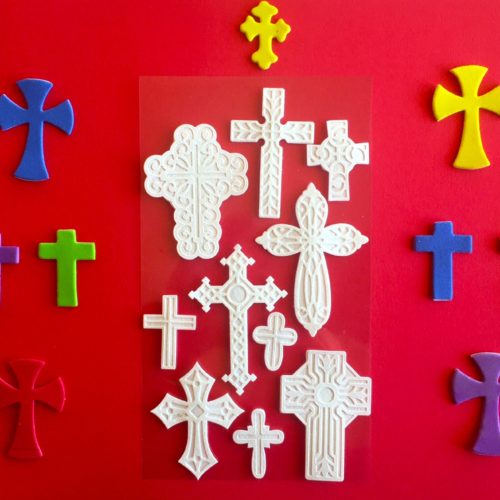The Second Sunday of Easter
“Give thanks to the LORD, for he is good, his love is everlasting.” Source: USCCB.org

For Parents To Teach To Their Children

“Divine Mercy Sunday”
An Excerpt from MagnifiKid!, April 11, 2021, Second Sunday of Easter or of Divine Mercy, Vol. 18. Part 5. Section 5. Page 4
“This feast was established by Saint John Paul II when he declared Sister Faustina a saint in 2000. In her diary, Faustina wrote that Jesus had told her: ‘It is my desire that the feast of the Divine Mercy be solemnly celebrated on the first Sunday following Easter.’ During this Easter Season, Jesus was to remind us that he rose from the dead to save us because his love for us is infinite, despite all of our sins. Today, the Church encourages us to ask for forgiveness through the Sacrament of Reconciliation so that we may become even closer to Jesus’ heart.”
Our Art Gallery
Divine Mercy Sunday, The Second Sunday of Easter
Both paintings were painted on cardboard packing materials using white chalk, kids’ liquid acrylic paint and glitter paint.
The Second Sunday Ends the Easter Octave. Easter Season Lasts 50 Days With Pentecost.
“The Church celebrates the joy of the Resurrection for 50 days, all the way to Pentecost! We celebrate each of the 50 days as if it were Easter Sunday.”
“At the beginning of the Mass, we sing or recite a prayer in honor of God. This is the ‘Glory to God’ or ‘Gloria.’ The first few words repeat the song of the angels in Bethlehem who celebrated the birth of Jesus. Like the angels, we in turn ay that God, our father , is great. We add that Jesus his Son is Lord and that he is as great as his Father. It is a song of praise and of joy that bursts forth at Easter and continues throughout the year until Advent.”
Source: Magnifikid! April 11, 2021, Vol.18. Part 5. Section 5. Page 14-15
Our Art Gallery
The Story of Jesus On “The Road to Emmaus” A Collage
“The Appearance on the Road to Emmaus.” USCCB Luke, Chapter 24:13-31 A Collage
“Now that very day two of them were going to a village seven miles from Jerusalem called Emmaus,
and they were conversing about all the things that had occurred.
And it happened that while they were conversing and debating, Jesus himself drew near and walked with them,
but their eyes were prevented from recognizing him.
He asked them, ‘What are you discussing as you walk along?’ They stopped, looking downcast.
One of them, named Cleopas, said to him in reply, ‘Are you the only visitor to Jerusalem who does not know of the things that have taken place there in these days?’
And he replied to them, ‘What sort of things?’ They said to him, ‘The things that happened to Jesus the Nazarene, who was a prophet mighty in deed and word before God and all the people,
how our chief priests and rulers both handed him over to a sentence of death and crucified him.
But we were hoping that he would be the one to redeem Israel; and besides all this, it is now the third day since this took place.
Some women from our group, however, have astounded us: they were at the tomb early in the morning
and did not find his body; they came back and reported that they had indeed seen a vision of angels who announced that he was alive.
Then some of those with us went to the tomb and found things just as the women had described, but him they did not see.’
And he said to them, ‘Oh, how foolish you are! How slow of heart to believe all that the prophets spoke!
Was it not necessary that the Messiah should suffer these things and enter into his glory?’
Then beginning with Moses and all the prophets, he interpreted to them what referred to him in all the scriptures.
As they approached the village to which they were going, he gave the impression that he was going on farther.
But they urged him, ‘Stay with us, for it is nearly evening and the day is almost over.’ So he went in to stay with them.
And it happened that, while he was with them at table, he took bread, said the blessing, broke it, and gave it to them.
With that their eyes were opened and they recognized him, but he vanished from their sight.”
Our Art Gallery
The Story of “The Doubt of Saint Thomas”
Learning Through Art
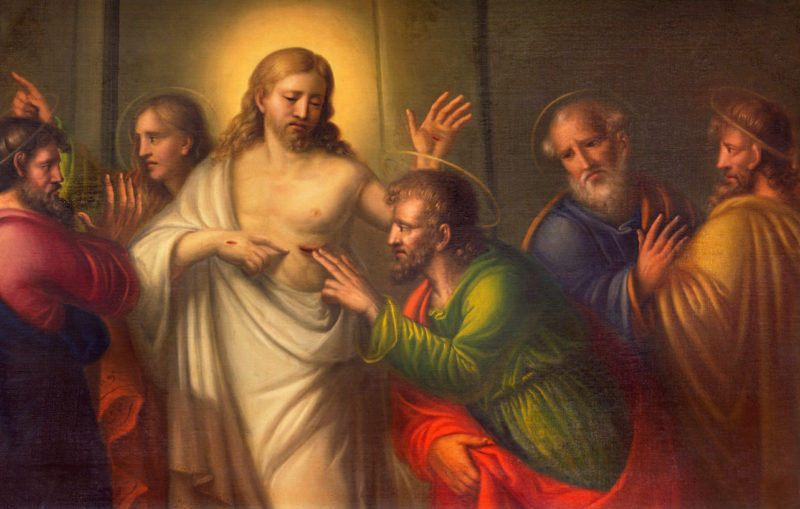
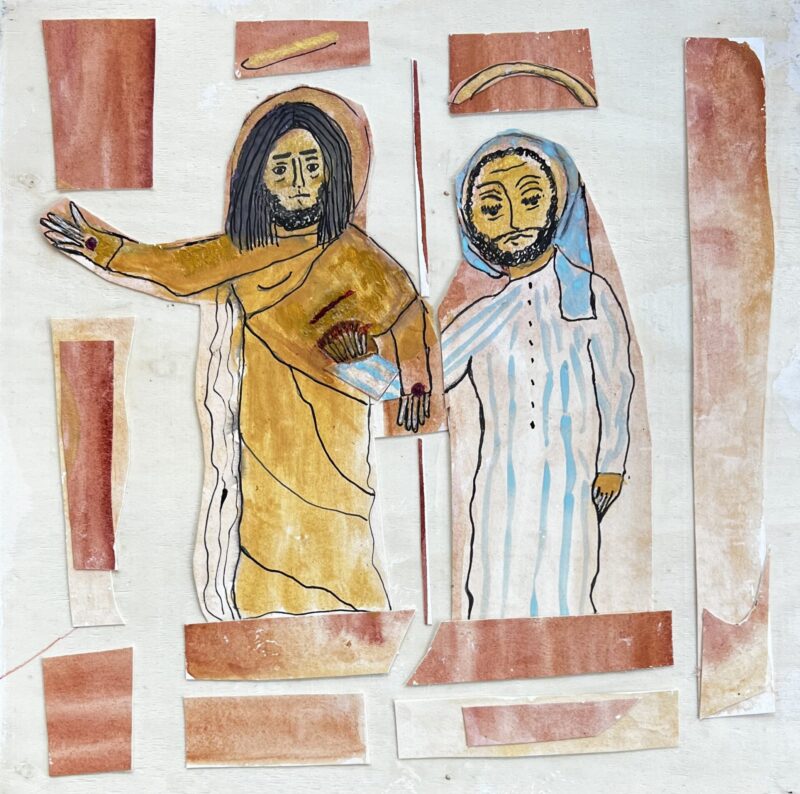
“Thomas.” USCCB John, Chapter 20:24-29″
“Thomas, called Didymus, one of the Twelve, was not with them when Jesus came.
So the other disciples said to him, ‘We have seen the Lord.’ But he said to them, ‘Unless I see the mark of the nails in his hands and put my finger into the nail marks and put my hand into his side, I will not believe.’
Now a week later his disciples were again inside and Thomas was with them. Jesus came, although the doors were locked, and stood in their midst and said, ‘Peace be with you.’
Then he said to Thomas, ‘Put your finger here and see my hands, and bring your hand and put it into my side, and do not be unbelieving, but believe.’
Thomas answered and said to him, ‘My Lord and my God!’
Jesus said to him, ‘Have you come to believe because you have seen me?
Blessed are those who have not seen and have believed.'”
This is a collage, from the original watercolor painting I made, based on John, in Chapter 20. I cut it into pieces and glued them to light-colored wood. I also used black micro pens, a gold, soft brush pen, and white highlighter. The halos were painted in gold acrylic paint.
Discussion Topics for Families
This is an Italian painting from the 1700s. Turin, Italy, where this was painted, is in Western Europe. Artists often portrayed Jesus as a person from the region the artist lived in. It’s possible that Jesus is blond in this painting because blonds were common in the region. Ask your children to look at the painting of Jesus (with more of a Jewish or middle eastern look) at the top of this page, and to look at Jesus in this painting above. What is different about the two artists’ visions of Jesus? Ask your children how they think Jesus looked.
“Doubting Thomas”
A Paraphrase from John, chapter 20:19-29
Source: The Catholic Children’s Bible
After Jesus’ resurrection, he came to visit his disciples. He entered a locked room, not walking through the door like a ghost. He simply appeared among them, and said, “Peace be with you.” He then showed the disciples his hands and side. He again said, “Peace be with you. As the Father sent me, so I send you.” Then he breathed on them and told them to receive the Holy Spirit.
“If you forgive people’s sins, they are forgiven; if you do not forgive them, they are not forgiven.”
One of the disciples was not with them when they all saw Jesus. This was Thomas. When the men told him they had seen Jesus, he replied, “Unless I see scars of the nails in his hands and put my fingers in those scars and my hand in his side, I will not believe.”
A week later, Jesus appeared among them again, this time with Thomas present. Again, Jesus said to the group, “Peace be with you.” Then he told Thomas, “Put your finger in here, and look at my hands; then reach out your hand and put it in my side. Stop your doubting and believe!”
“Thomas answered him, ‘My Lord and my God!'”
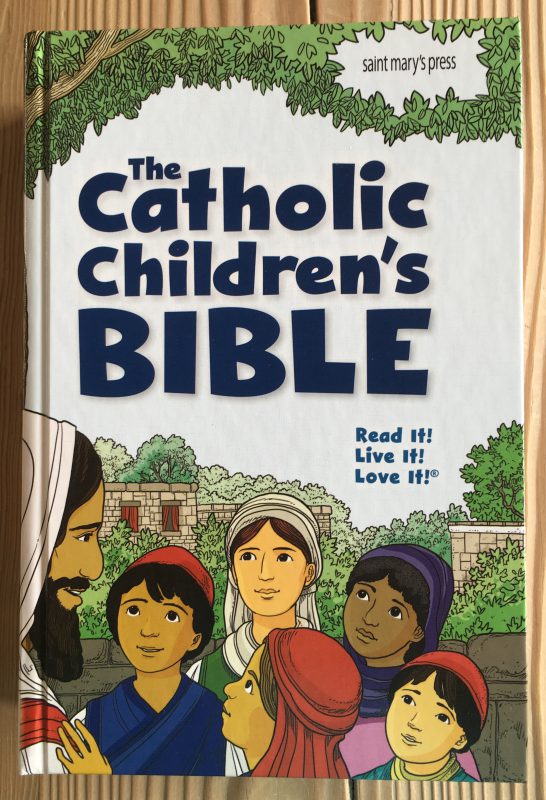
Our Prayer–The Nicene Creed
What Is a “Cornerstone?” A Family Discussion
“Alleluia.” “The stone which the builders rejected has become the cornerstone.”
Psalms, chapter 118 USCCB.org
The Oxford Dictionary defines “cornerstone” as, “A stone that forms the base of a corner of a building, joining two walls.” If the cornerstone was to be removed, the wall or building could fall down. Another meaning is, “An important quality or feature on which a particular thing depends or is based.” For example, we can say that the family is a cornerstone of society. The family is an essential building block of a strong society. In the reading from Psalms, chapter 118:22, the meaning is still more complex:
According to the USCCB.org, “The stone the builders rejected: a proverb: what is insignificant to human beings has become great through divine election. The “stone” may originally have meant the foundation stone or capstone of the Temple. The New Testament interpreted the verse as referring to the death and resurrection of Christ.”
In other words, the cornerstone for us and all Christians, is Jesus. Here are three photos from Israel that might help you define this for your children. With the photo of the wall, you might ask your children what would happen if a rock at the based were to be removed.
Art Project for “Cornerstone”

“Christ Is Risen”–Icon Art Project for this Easter Season
Use an uncoated paper plate (Smart and Final and Costco) and smear it with kids’ washable metallic gold paint, using fingers, a sponge or brush. Let dry. Use Easter and Christian-themed rubber stamps with washable ink pads to decorate. Cross and flower stickers add color and beauty to the design. Invite your child to use a finger tip dipped in washable tempera paint to further decorate. Punch a hole at the top of the plate and use a ribbon to hang it prominently! This is a fun and easy craft for kids of various ages.
Our Materials
Week 38–Suggested Family Activities
If you have not already, please read the “Glorious Mysteries” of the Rosary to learn what happens after Jesus is crucified. As you pray the Rosary, please read one every Sunday for five weeks during this Easter season.
The Glorious Mysteries (These are recited Wednesdays and Sundays)
- “THE RESURRECTION (Matthew 28:5-6)”
- “THE ASCENSION (Mark 16:15)”
- “THE DESCENT OF THE HOLY SPIRIT (Acts 2:4)”
- “THE ASSUMPTION (Revelation 12:6)”
- “THE CORONATION” (Revelation 12:1)”
The Glorious Mysteries from Rosary-Center.org
Please read John, chapter 20:19-29 from USCCB.org.
Also read “The Road to Emmaus” Luke 24:13-35 in the Catholic Book of Bible Stories pages 188-190. Please have your child read out loud, “Faith to Grow” and “Prayer.”
For additional Enrichment: “On the Road to Emmaus” (Luke 24; John 20) pages 278-279 in The Children’s Illustrated Bible has helpful illustrations and information about the town of Emmaus, the disappearing of Jesus, and includes a French illustrated manuscript of “Doubting Thomas.”







